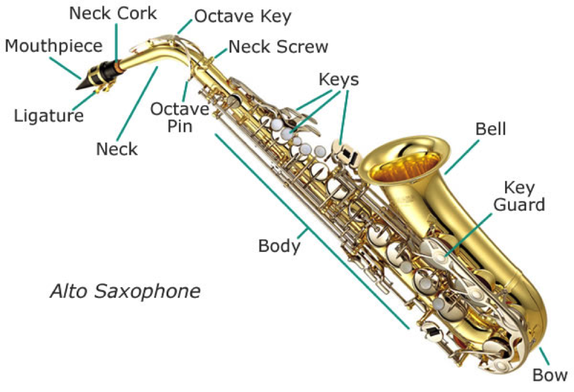Saxophone Set-Up, Care, and Cleaning
- Set your case down on a flat surface, and make sure the latches on the case open upwards. You don’t want to open the case upside down! Some very old cases may be the opposite – the latches open toward the bottom of the case. In this instance, a sticker placed on the top of the case will ensure you never open it upside down.
- Build from the smallest pieces, starting with the reed and mouthpiece:
- Loosen the screws on the ligature (but do not remove them).
- Slide the reed into the ligature. The reed should line up with the tip of the mouthpiece so that if you are looking at it straight on, you should just barely see the tip of the mouthpiece. The screws on the ligature will always point to the right.
- Tighten the ligature. It should only cover the hard part of the reed (you’ll see a line on the reed separating the soft end from the hard – don’t cross this line). The ligature should also only cover the barrel of the mouthpiece (that is, don’t let it hang over the sloped part, called the beak). You only need to tighten the screws enough to keep the reed snugly in place.
- Gently push the mouthpiece onto the neck, rotating the mouthpiece as you push it onto the cork. If you’re having trouble, add a light amount of cork grease and spread it around the cork with your fingers. Don’t force the mouthpiece on or you may crack it. How far you need to push the mouthpiece depends on the saxophone, as this effects the tuning. You’ll eventually learn what works best. When on correctly, the reed will be facing the ground.
- Hold the saxophone by the bell so you aren’t pressing any keys. Attach your neck strap to the body of the saxophone by hooking it onto the neck strap ring. Sit down and rest the sax on your lap while you finish assembling it.
- There is a neck screw at the top of the body of the saxophone. Loosen this screw and then gently push the neck into the body while simultaneously rotating the neck into place. Make sure the octave pin on the inside of the neck’s octave key. The neck is designed to fit snugly onto the saxophone, so if you’re having trouble it means either the neck screw is still too tight or that the neck tenon is damaged. Do not add oil or cork grease to the neck to make it fit better – take your instrument into a repair shop. You can also try cleaning the tenon with some rubbing alcohol and a soft cloth.
- The neck should be straight on the sax, and not cocked to the left or right. Once set, your saxophone is ready to go! If you are holding your saxophone to the side of your body while seated, you will need to rotate the mouthpiece clockwise so that you don’t have to tilt your head to play.
- When returning the instrument to its case, be sure to insert a plug into the top of the body to avoid damaging the octave pin. Not all saxophones include one, so you may need to purchase a saxophone end plug. Do not store the reed on the mouthpiece, and always unhook the neck strap when storing. Do not store music in your case unless there is separate, dedicated pouch for this purpose.
- Always clean out your instrument with a cleaning swab when you are done playing it. These can be purchased online or at any music store. Run the swab through the body of the saxophone by dropping the weight into the bell.
- Note that many cleaning swabs are a little too large for alto and soprano saxophones and may need to be cut down to avoid it snagging on pieces inside the saxophone. If a swab does snag, very carefully work the swab out – bent tubing inside the saxophone is very challenging and expensive to repair.
- The neck can be cleaned with a specialty neck swab. These have a thick cloth on one end a scrubber on the other end. You generally only need to run the cloth end through the neck.
- If you have chronically sticking keys, purchase some cleaning paper and insert this between the keys after every playing session.
- You should clean the mouthpiece couple of weeks, or more often depending on how frequently you are playing. The mouthpiece can be cleaned with warm water, mild soap, and a non-abrasive cloth (preferably silk). Remove the reed and ligature when cleaning. Do not use anything abrasive (such as paper towels) to clean the mouthpiece! Even tiny scratches on the inside can have a major effect on its sound quality. Never boil a mouthpiece to disinfect it. Disinfectant sprays for wind instruments are available for purchase, but unless one is frequently sharing their mouthpiece, they aren’t usually necessary.
- Never submerge your saxophone in water! If it needs a deep cleaning, take it to an instrument repair shop where they have a special method for cleaning instruments. A technician may recommend this during an annual check-up.
- Never attempt to polish your instrument. If necessary, smudges can be removed with a very damp cloth and some mild soap.
- Your instrument is fragile, so be sure to hold it carefully and closely. It is very easy to bump the neck or mouthpiece against objects around you, including your body or chair, and it’s even easier to crack the reed if you aren’t aware of it. Denting your instrument could make it unplayable!
- Always remove the reed and neck strap when storing your instrument.
- Insert a saxophone end plug into the top of the body whenever it is in its case to avoid damaging the octave pin.
- A technician should check out your instrument once a year. They will check for air leakages, faulty pads, sticky keys, loose screws, old cork, and other issues. Most annual tune-ups cost around $70-$100, but expect to pay more if there is a major issue found or parts need replaced.
- Avoid exposing your instrument to large swings in temperature and climate. Don’t store it outside or in your car. Sudden changes in climate can effect the instrument’s tuning.
- If pieces of the instrument become stuck or overly tight, take your instrument to a repairman. Do not attempt to loosen anything on your own with household tools.
- Do not eat or drink sugary foods before playing. This can cause sugar build up in the keys that will damage the instrument.

